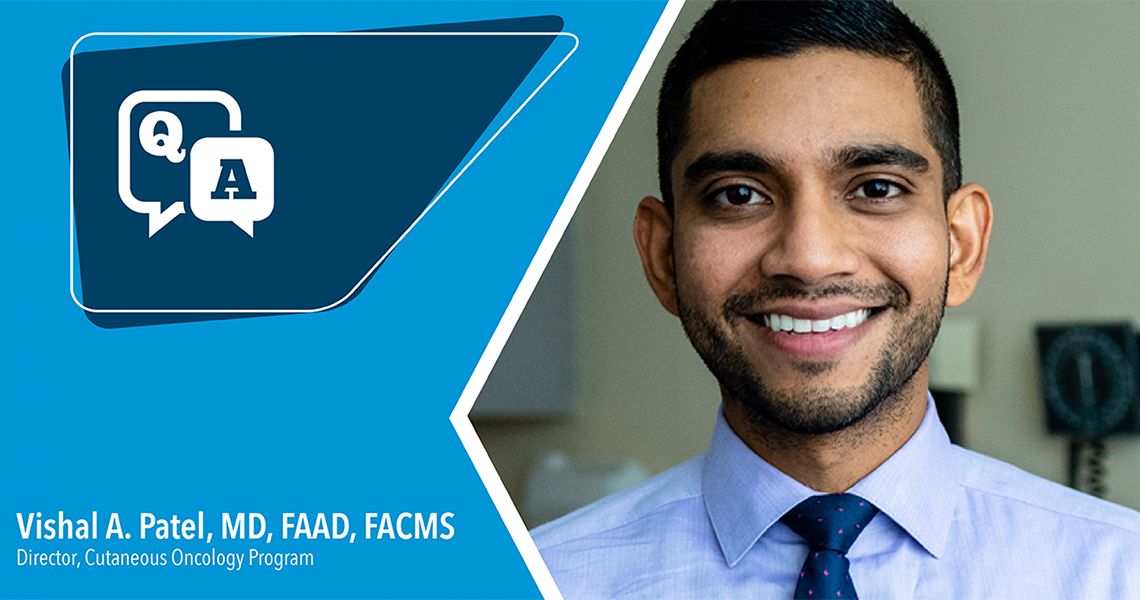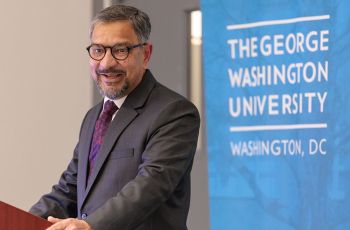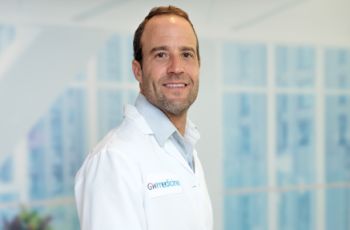Dr. Patel is an accomplished Mohs/dermatologic surgeon and dermatologic oncologist. He also serves as director of the cutaneous oncology program at the GW Cancer Center, which brings together dermatologists, dermatologic surgeons, medical, surgical and radiation oncologists, and dermato-pathologists to provide comprehensive and personalized skin cancer care to patients.
What brought you to GW?
I was recruited by Eduardo Sotomayor, MD, Dr. Cyrus Katzen Family Director of the GW Cancer Center, and Adam Friedman, MD, FAAD, interim chair of the Department of Dermatology at the GW School of Medicine and Health Sciences and director of the Supportive Oncodermatology Clinic at the GW Cancer Center, to lead and build a comprehensive skin cancer program. Washington, D.C. has lacked a skin cancer center of excellence and I saw this as an opportunity to build something lasting and meaningful that would elevate GW and impact a large number of patients. Furthermore, I wanted to be part of the new GW Cancer Center which I believe is a unique place to practice medicine and be part of a multi-disciplinary team.
How did you decide on a career in dermatologic oncology?
After medical school, I spent a lot of time working in sub-Saharan Africa and was exposed to various types of skin infections and advanced cutaneous malignancies. This led me to training in dermatology where I enjoyed treating patients with malignancies that I could see and also potentially surgically remove. Furthermore, I found the management of complex tumors that required a more multi-faceted approach to be extremely interesting. I ultimately decided to pursue fellowship training in Mohs Micrographic Surgery and Dermatologic Oncology and focus my career on cutaneous oncology.
If you weren’t in the field of cutaneous oncology, what would you be doing?
I would have pursued a career in global health dermatology focusing on infectious and dermatologic diseases in developing countries.
What inspires you most about your work?
Cutaneous oncology is a field that stretches over multiple specialties. As a result, patients often get varied recommendations and care. They also have to process and understand overwhelming information to manage their disease. I am inspired by being able to help patients navigate through all the various aspects of cutaneous oncology management and help them decide what is best for themselves and their families.
What is a current project or work you are excited about and why?
I helped co-found the SCOUT (Skin Cancer Outcomes) Consortium with one of my mentors. This is an organization that aims to advance skin cancer research by bringing together dermatologists, dermatologic surgeons, medical, surgical and radiation oncologists, and dermato-pathologists to work together to build consensus on how we approach cutaneous malignancies. Our aim is to help bring together what have traditionally been siloed specialists working in their own sphere, so that we may work more effectively together to advance research and clinical trials at a more efficient and rapid rate.
What makes the GW Cancer Center unique when it comes to patient care?
The GW Cancer Center is focused on comprehensive care. This extends beyond the clinical specialists and includes a team of nurses, social workers, patient advocates and navigators, all who work to provide compassionate and personalized care to our patients. The GW Cancer Center is unlike other large cancer facilities and provides a more intimate boutique experience for patients. It is refreshing to be part of a more humanistic and personal approach.
Summer is a great time to remind people to practice sun safety - what are a few things the average person can do to protect their skin from damage during the summer?
There are many things you can do to protect yourself from UV radiation (the sun's rays that are harmful to the skin) exposure. Obviously, using sunscreen helps, but many people forget to use it or, even more commonly, forget to reapply as the sunscreen wears off after about 2 hours. So I often advise people to wear sun protective clothing. A simple shirt doesn't provide good sun protection, but now many athletic and swimwear garments have SPF built in. If you are playing tennis or swimming, wearing a sun protective long sleeve shirt or rash guard will help protect you continuously.
Another easy strategy is to plan your day around knowing when UV exposure is at its peak, which is between 11AM and 3PM. If you can avoid being outside or doing an outdoor activity at this time, it will lower your exposure to the strongest rays from the sun. Lastly, don't forget that you can still get UV exposure in non-summer or cloudy days as well! UV sun rays can pass through clouds are even present in the winter, so try to get in the habit of practicing UV safety year round.




